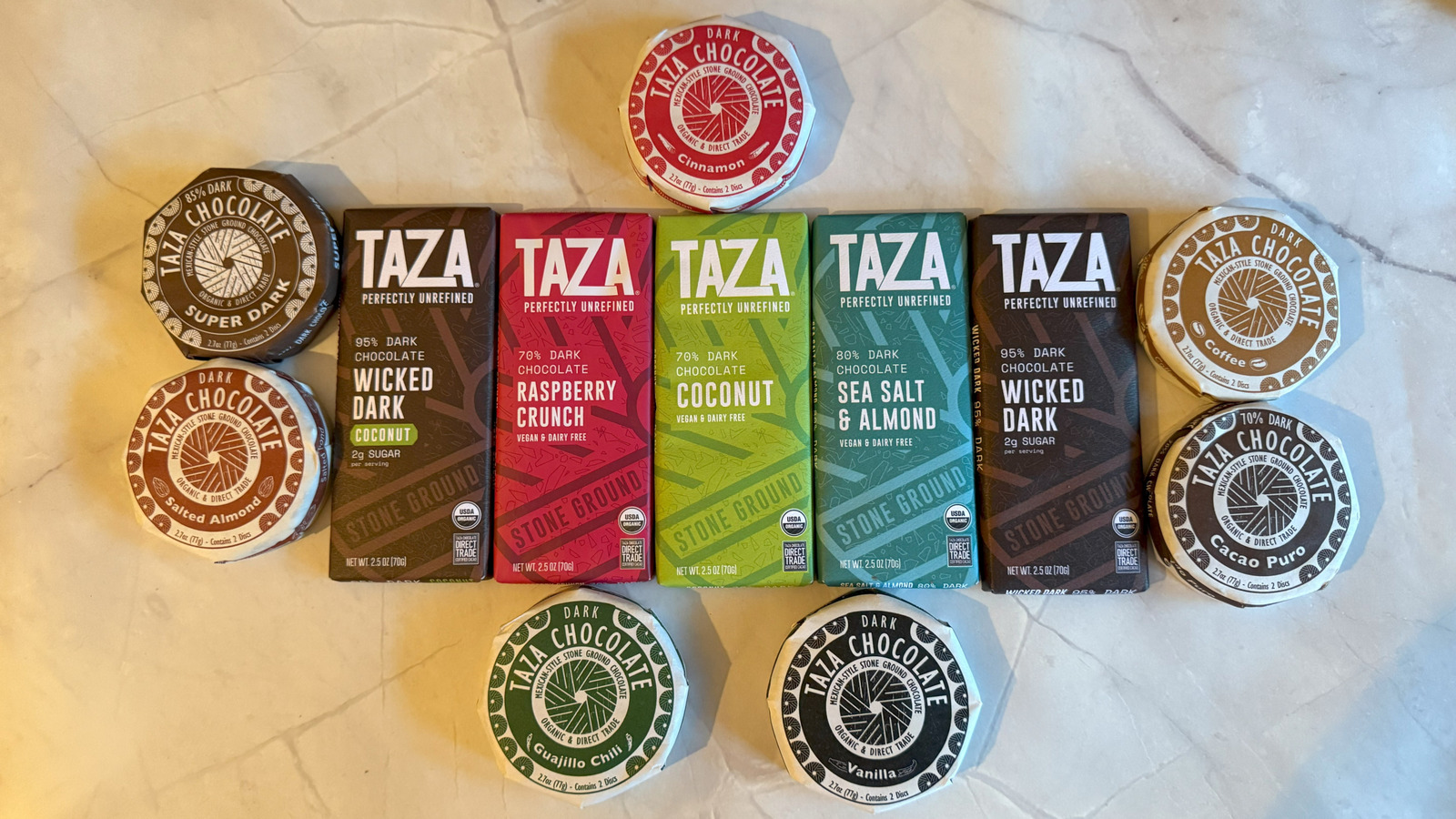We may receive a commission on purchases made from links.
If your go-to chocolate is starting to lose its lustrous appeal, or you simply want to switch things up every once in a while, a few bars from Taza’s line of stone ground Mexican chocolates might be in order. With the slogan “perfectly unrefined,” you can expect these products to be quite different from your regular, run-of-the-mill chocolates. Taza’s chocolates are even a world apart from confections offered by other high-end brands.
Aside from their top-tier ingredients, part of what makes these products unique is their coarse texture. The slightly crumbly, sand-like texture of these chocolates reflects their minimally processed nature and the fact that the cacao beans are ground using hand-carved molinos, stone mills that are traditional to Mexico. Additionally, because stone-ground chocolate is processed at a lower temperature than other chocolate, these chocolates also present a different set of flavors. In other words, if you have ever struggled to taste the floral, fruity, and nutty notes of chocolate, your palate might not be to blame. Perhaps you just need to try Taza’s chocolates.
Taza offers a variety of products, including Mexican-inspired flavors, shaped into discs and bars, which I reviewed for this ranking. The discs tended to be grittier and are usually consumed either plain or in hot chocolate. For the most part, the bars are much smoother in texture, though still with a unique crunchiness not found in other chocolates. Based on my experiences tasting chocolate in workshops around the world, I have ranked each product according to flavor and texture, often comparing them to similar chocolates from other brands. Additional notes on methodology can be found at the end of this article.
12. Cinnamon disc
Taza’s cinnamon discs disappointed me. Don’t get me wrong — this is still a high-quality chocolate that will wow your taste buds. However, despite this product’s name and the fact that it contains just three ingredients (organic cacao beans, organic cane sugar, and organic cinnamon), the cinnamon flavor was too subdued. It came as an aftertaste and provided just a smidge of warmth to the chocolate. I would, therefore, choose another one of Taza’s discs over this one.
Not one to waste food, I used the rest of this disc to make hot chocolate, and I would recommend adding extra cinnamon when doing so (perhaps in the form of a cinnamon stick, which is commonly used to make Mexican hot chocolate). Meanwhile, if you are looking for a cinnamon-rich chocolate to eat by itself, I suggest sampling Endangered Species’ cinnamon, cayenne, and cherries chocolate instead. It might be easier to find this latter product online than in stores.
11. Cacao puro disc
Taza’s cacao puro discs are made with 70% dark chocolate, simply composed of organic cacao beans and organic cane sugar. These discs are pleasantly gritty and not overwhelmingly sweet. If you want to taste the natural flavors of cocoa but don’t want to wander too far over to the dark side, you should consider starting with this product.
This disc tasted great plain, but it didn’t stand a chance compared to the products on this list with additional pizzazz. I enjoyed it more as a baking ingredient and hot chocolate base. A safe choice for fans of dark chocolate, it could potentially win over the hearts of those who typically prefer milk chocolate. Even so, be warned that it is still a little bitter, so the latter crowd may prefer it melted into a ganache for a sweet cake or chopped and mixed into a batch of double miso chocolate chip cookies. When using these discs to make hot chocolate, I suggest experimenting with spices like ginger, star anise, and nutmeg.
10. Super dark disc
Taza’s super dark discs are, indeed, super dark. In fact, this 85% dark chocolate features nothing more than organic cacao beans and organic cane sugar. While this chocolate was bitter, it still had room to grow. It has distinctly fruity notes and a slight smokiness.
This disc would perform superbly well as hot chocolate alongside a drop or two of peppermint extract. I also recommend pairing it with sweet ingredients; for instance, it would go great in this dark chocolate-tahini cottage cheese ice cream. My main critique of this product lies in its signature stone-ground texture. When chocolate is this bold and bitter, I prefer it to have a smooth, gentle texture for a more well-rounded tasting experience.
9. Wicked dark bar
If you are on the hunt for a fruity, nutty, and floral dark chocolate and don’t mind a bit of bitterness, look no further than Taza’s 95% wicked dark bar. Slightly acidic and coarse in texture, this bar is a bold choice and admittedly not the one for you if you generally prefer milk chocolates or anything under 70% cocoa. Even so, you could become accustomed to its taste by pairing it with sweeter flavors; for instance, in a customizable recipe for date candy.
This bar offered an extremely complex tasting experience. When I allowed a portion to melt in my mouth, I was treated to the chocolate’s rich, creamy mouthfeel and a sampling of its terroir. When I bit into the chocolate, however, even more flavors were released, and at a much higher intensity. Though I love even the darkest and bitterest of chocolates, I was pleasantly surprised by the subtly sweet aftertaste of this chocolate. Because I like smoother textures in dark chocolates with cocoa ratings over 90%, this was not my favorite variety of extreme dark chocolate — that is a title currently reserved for Beyond Good’s 92% cocoa bar. However, it still pleased my palate, and I ate the rest of the bar with dates and peanut butter.
8. Salted almond disc
Taza’s salted almond discs, which are only 44% dark, are a nice entry point to Taza’s product line for those who prefer sweeter chocolates. They feature organic cane sugar and cacao beans for the base flavor, as well as their namesake: organic almonds and sea salt. The key to enjoying these discs is to go in without expectations.
Given the name, these discs were not as salty or as almond-forward as I expected. However, the salt did offer a pleasant aftertaste, and it was more noticeable when I allowed the chocolate to melt in my mouth. Since this chocolate is only 44% dark, the salt provided a lovely contrast to the relative sweetness of the chocolate. Meanwhile, while there were no large chunks of almonds, I could still detect the nuts’ subtle flavors. I found this subtlety unique and a characteristic that differentiated this product from other almond-laden chocolates. While I liked this chocolate, I would have preferred more salt — perhaps in granules. If you are a fan of salted hot chocolate or salted mochas, these discs might be for you. They can also be melted down into a sheet of chocolate almond bark.
7. Sea salt and almond bar
Because almonds and chocolate share many of the same flavor compounds, they are often revered as a match made in heaven. Just consider Germany’s chocolate-dipped almond horns or Italy’s chocolate amaretti. Taza’s sea salt and almond bar is no different. With just the right amount of salt and exquisitely flavorful almonds, this product has the ability to please most people, even with an 80% dark chocolate content.
The almonds were not too chunky, as I have often found to be the case with competitors’ versions. In contrast to the salted almond disc, the texture of the almonds was very much detectable in this bar. I could certainly tell that the almonds were roasted, and their natural sweetness helped balance out the bitterness of the chocolate. My main complaint is that I would have preferred a flakier variety of salt, such as fleur de sel or Maldon salt, for a bolder bar. I suggest enjoying this bar plain so you can better appreciate its varied texture.
6. Coconut bar
Taza’s coconut bar is 70% dark and consists of organic cacao beans, organic cane sugar, organic coconut, organic cocoa butter, and sea salt. Though I preferred a different coconut offering, I was nevertheless happy to savor this chocolate as well.
This bar reminded me somewhat of a Bounty bar in flavor, but with richer chocolate, toastier coconut, and a coarser texture. Plus, the coconut-to-chocolate ratio was much lower in Taza’s bar than in a Bounty bar. Despite this, the coconut was still able to stand out as a star ingredient because it was not overpowered by a ton of sugar. Similarly, the sea salt was detectable, but definitely not to a degree that it distracted from the other flavors. Tropical, yet dark, this product can be enjoyed plain and by the rectangle, or you can incorporate it into your baking. I suggest making a batch of coconut chocolate chip cookies.
5. Coffee disc
Why do so many chocolate brands offer bars starring coffee? Chocolate and coffee complement one another partly because they frequently share a similar terroir. Not to mention, both products are typically fermented and roasted before being processed and presented to consumers. Coffee-flavored chocolates can sometimes toe the line of being too bitter, but Taza’s coffee discs, which contain 55% dark chocolate, are pleasantly bitter without being overwhelming.
Composed of three simple ingredients — organic cacao beans, organic cane sugar, and organic coffee beans — this chocolate provides a supremely smooth coffee flavor, likely because of how finely ground the coffee beans are. This is in contrast to other coffee-flavored chocolate bars featuring chunks of beans. Certainly, these discs provide a different experience than munching on, say, Trader Joe’s dark chocolate-covered espresso beans. I recommend breaking this disc into pieces and consuming it unadulterated, but it would also taste lovely melted into mocha mousse or chopped into espresso chocolate muffins.
4. Guajillo chili disc
Taza’s guajillo chili disc was, to my surprise, a sweet chocolate. That is, in addition to it being a bit spicy, of course. It makes sense that Taza would offer a disc flavor starring chili peppers, given that Mexico is famous for its peppers. Plus, chili and cocoa is a combination that dates back at least 3,500 years, when Mayans savored the two ingredients alongside cornmeal in a drink known as xocolatl.
The heat in this chocolate is sharp and hits the back of the palate near the throat, but it’s not a mouth-pervading spiciness like you might find in a curry. In other words, it’s a manageable heat balanced by the sweetness of the chocolate — after all, it’s only 50% dark. While you could enjoy this disc plain, I recommend stirring it into a cup of hot chocolate for a midday pick-me-up. Other folks who have purchased this chocolate note it could be used for mole, chocolate chip cookies, or a bowl of ice cream.
3. Vanilla disc
Vanilla was traditionally used to complement cacao beans, ground corn, and honey in ceremonial Aztec drinks, and it remains prevalent in countless brands of chocolate today. A large part of its appeal is that it helps mitigate the acidic and bitter aspects of chocolate. Taza’s vanilla disc was easily one of my favorite chocolates on this list. Its spectacular flavor is derived from just three ingredients: organic cacao beans, organic cane sugar, and organic vanilla beans.
With a cocoa content of 50%, this disc was not too bitter. In fact, it was a notably sweet chocolate, thanks in part to the refreshing flavor of the vanilla beans, which were especially noticeable in the chocolate’s aftertaste. Furthermore, the quality of the vanilla beans was readily apparent and far superior to the (frequently artificial) vanilla flavorings found in other chocolates. Because vanilla beans are so well suited to custards and sauces, I recommend using this product in such recipes (that is, if you can resist eating it straight from the wrapper!). It would also work mixed into a traditional spumoni ice cream cake.
2. Raspberry crunch bar
Taza’s raspberry crunch bar was unlike any other raspberry chocolate I have tried. Part of what distinguishes it from other brands is its use of raspberry oil. Other brands use dried raspberries or raspberry powder for their bars. When added to chocolate, oils help evenly distribute flavors without affecting texture. The raspberry oil in this Taza bar prevents the chocolate from tasting too tart, as often happens when flecks of raspberry are incorporated into chocolate. Though the raspberry oil in Taza’s bar is composed of vegetable oil and natural flavors, I found the taste to be spot on.
In addition to the wonderful raspberry flavor, the puffed quinoa in this bar added a delightful crunch. In doing so, it did not impart any of quinoa’s earthy, bitter flavors. This is sometimes the case with bars that have puffed quinoa sprinkled on top, but by incorporating quinoa into the bar itself, the sweetness of the chocolate helped complement it. This 70% dark chocolate bar is an ideal choice for dessert, whereas some of the other products are more bitter and well-suited for snacking and baking. There is no need to doctor it up by incorporating it into hot chocolate or cookies; simply snap off a rectangle and enjoy!
1. Wicked dark with coconut
Taza’s wicked dark with coconut bar was phenomenal. It was also not what I expected. Despite this bar being 95% dark chocolate, its natural sweetness was high, thanks to the addition of coconut flakes. I have eaten plenty of coconut-infused chocolates in the past, from Bounty bars and Almond Joys to Theo’s 70% dark chocolate coconut bar and Alter Eco’s 47% coconut toffee bar. None have even come close to matching the coconut flavor in Taza’s version.
In fact, only on very rare occasions have I been able to detect such floral, nutty notes in dried coconut as I was able to in this bar. There’s a reason for that: The coconut is toasted, which helps caramelize its sugars and elicit both sweet and nutty flavors. Plus, because this bar is made with organic cacao beans, organic coconut, and organic cane sugar, both the chocolate and the coconut are allowed to shine without being overshadowed by unnecessary ingredients like soy lecithin and artificial flavors. I recommend eating this bar straight from the package to better appreciate its complex tasting notes.
Methodology
It’s safe to say that I have eaten more varieties of chocolate than the average Joe or Josefina. From Indian chocolates to Belgian chocolates, and from the lightest of milk chocolates to the bitterest of 100% dark chocolates, I enjoy a piece (or two or three) nearly every day. Not to mention, I have taken part in at least five chocolate tasting tours and workshops around the world.
My experiences informed the rankings I assigned to each product in this article. I chose products that were readily available in brick-and-mortar stores, and I based my assessments on quality of flavor and texture, frequently using similar flavors from other brands as points of comparison. I also used a tasting wheel to help hone in on specific flavor profiles. I did not refer to anyone else’s opinions, either online or in person, when forming my opinions about each chocolate.





